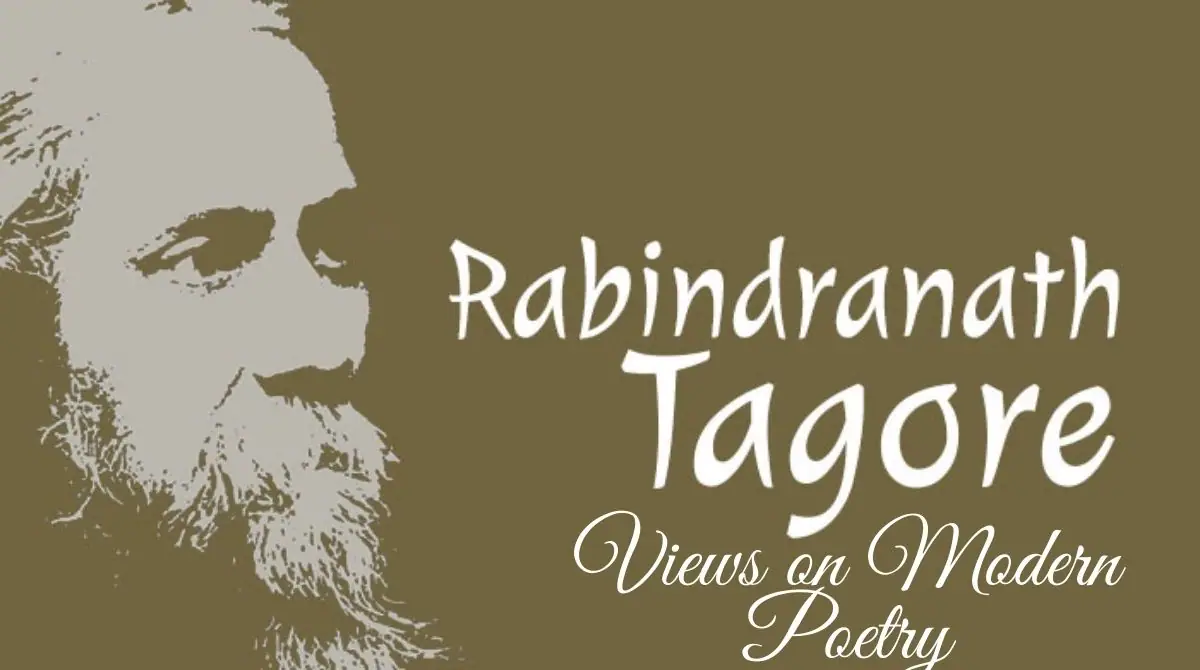Rabindranath Tagore’s Views on Modern Poetry
Tagore’s Views on Modernism
Rabindranath Tagore’s essay on Modern Poetry was originally published as Adhunik Kavya (1932) in “Sahityer Pathe”, his anthology of literary critics. In this essay, Rabindranath shows his intimate knowledge and deep interpretation of Modern Poetry- specially the poetry of T.S. Eliot.
He is surprisingly modern in his attitude to contemporary and European poets. Here he deals primarily with what he considers to be essense of modernism. And it must be remembered that he wrote the essay before the advent of what we today call post modernist literary trends.
Tagore wrote that modern age should not be considered by the almanac. For him modernism is not a matter of dates or chronology. He does not pin down what is modern to a particular period, but trends to see modernism as a unique or particular kind of perception as a fresh way of looking at life and art.
This may be present in a Sophocles or a Sudraka in a Homer or Vyasa as much as in Eliot, Jibanananda. Tagore says that poetry written in the twentieth century may not be modern in perception direction or relevance. On the other hand, poetry written thousands of years ago may contain modern elements that many of our chronologically ‘Modern Poets’ may lack.
Tagore very commonsensically points out that all ages think themselves to be modern. The Romantics thought that Augustines conservative and traditional and thought themselves modern. The Victorians thought themselves to be modern. We think the Victorians old fashioned and think ourselves to be modern.
But by a few generations in the future we will be considered as old fashioned or unmoderned. Tagore says that the modernity is akin to greatness in poetry. And great poetry has nothing to do with chronology. Actually all the great poets have a fresh vision of a reality which is the essence of modernism and this perspective is limited to no particular age or period- “It belongs to everyone whose eyes know how to look.”
Tagore illustrates this point by stating that the Chinese poet Li Fo wrote and lived over a thousand years ago, and yet his poetry sounds a modern note because he combines in his poetry a perception of beauty with a perception of struggle and darkness and shows beauty emerging even from struggle and terrible reality.
Rabindranath gives us an analysis of truly modern poetry, that is both modern and great or enduring at the same time. T.S.Eliot is indeed, the first great representative of the modern spirit. Tagore gives us a profound and intimate analysis of Eliot’s poetry, brings before us Eliot’s nightmare vision of the green and filth, immorality corruption and violence of the contemporary urban life. Rabindranath has a truly insightful and a very close understanding of Eliot and his poetry. Tagore quotes from Eliot-
“I am moved by fancies that are curled
Around these images, and cling,
The notion of some infinitely gentle
Infinitely suffering things”
To prove his arguments he shows us the tenderness, the compassion and the sober hope even in such nightmarish poem as “Preludes” and “Wasteland”. Eliot sees the despair in modern life, sees it steadily and communicates it without elusion, without sentimentality. But Eliot also sees tenderness, humanity and hope still flickering in the hearts and lives of the contemporary men and women. According to Tagore, this double vision of Eliot makes him both a modern poet and an enduring world poet of the greatest structure.
By analysing Eliot, Rabindranath attacks the aggressive and fashionable modernism that denies beauty, tradition and the past, and tries to smash and destroy all that is good and positive. This is negative modernism while true modernism is for Rabindranath a strong and bright point of view that looks upon the universe without elusion, without sentimentality, with fresh and natural eyes. It is a clear sighted vision of reality that takes in both darkness and light.
You May Like To Read More:
